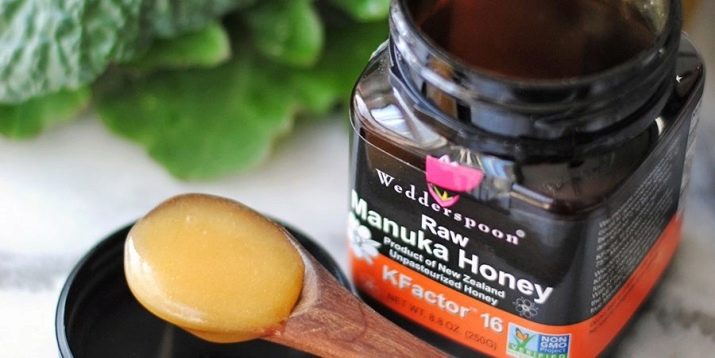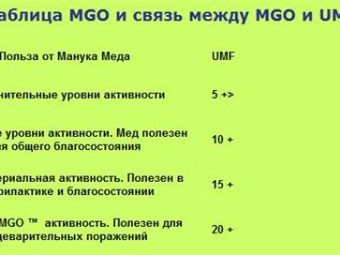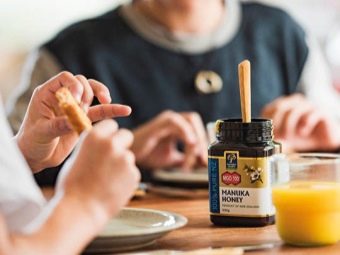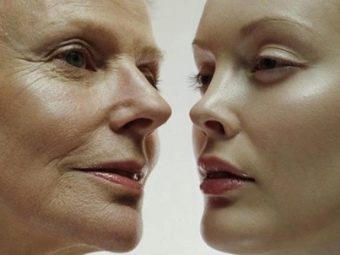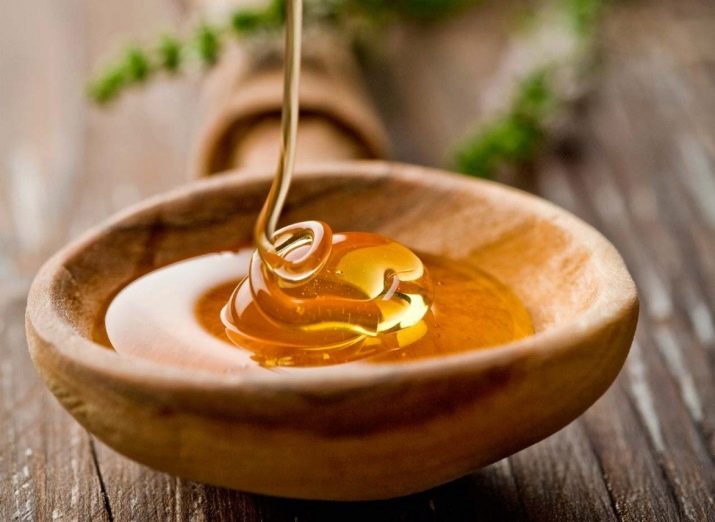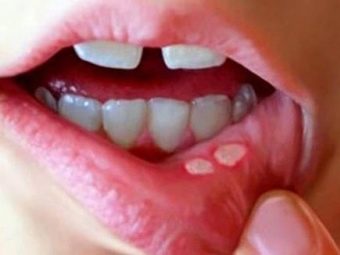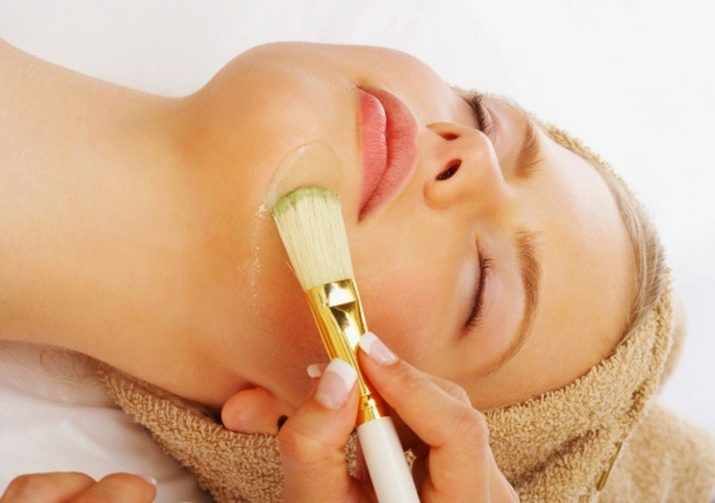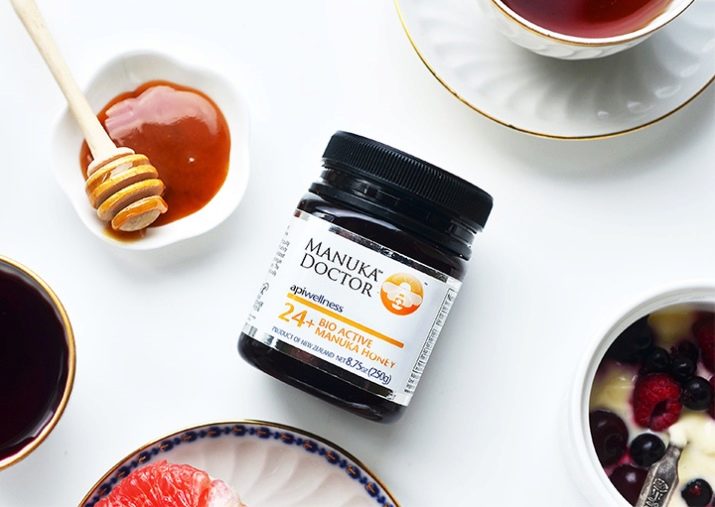Features of New Zealand honey "Manuka"
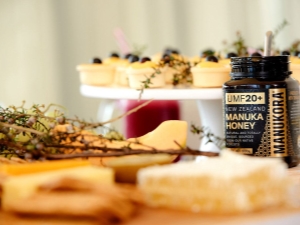
On Earth there is a unique primeval place - the island state in the Pacific Ocean New Zealand.Soils, vegetation and wildlife here were formed many millennia ago and did not actually change. Nearest neighbors - 1500 kilometers. The isolation of the location of the islands made it possible to preserve these lands in ecologically untouched clean. It is here that the bees get their precious product - “the king of honey” with the unusual name “Manuka”.
How to produce
For the production of honey, bees collect nectar from a low shrub of a thin broom seedling, belonging to the myrtle family, a variety of tea tree. In our country, this plant is well known for the bactericidal pharmaceutical preparation "Tea Tree Oil". Honey has even more active antibacterial properties. It is exported to many countries, but in small quantities, since no more than 120 tons are produced per year.
Honey stimulates the immune system well and actively influences pathogenic flora and even Staphylococcus aureus, which is difficult to treat. In the language of the aborigines, the word "manuka" means cheerfulness, cheerful mood, enthusiasm. Back in the old days, the locals noticed the healing and toning properties of the product. The state of New Zealand certifies Manuka products on its islands. Unscrupulous farmers using sweet bait, are deprived of the right to produce honey. Therefore, "Manuka" goes on sale only high quality.
Composition
The composition of Manuka honey depends on many factors. Bees react to weather changes, humidity levels, temperature fluctuations, the intensity of flowering of the honey-bearing plant - all this is reflected in the product. The composition of honey of different periods of collection may vary slightly. It can be characterized as follows:
- liquid - 16%;
- sugar - 84%;
- vitamins PP, K, E, H, group B and acids - 1.5%;
- mineral substances (iodine, potassium, calcium, iron, phosphorus, copper) - 15%;
- enzymes, proteins, antioxidants - 15%.
The particular value of this unique product is the presence of the substance methylglyoxal (MGO). Scientists have noticed that the percentage of it in New Zealand honey literally rolls over. Methylglyoxal, getting into the affected cells, inhibits pathogenic bacteria, Staphylococcus aureus sticks and other pathogenic flora.
New Zealand scientists have developed a scale of activity of honey - UFM (the uniqueness of the factor "Manuka"), according to which they classified the product as follows:
- neutral - 30+ MGO, 5+ UFM;
- insignificant - 100+ MGO, 10+ UFM;
- high - 250+ MGO, 15+ UFM;
- very high - 400+ MGO, 20+ UFM;
- overactive - 550+ MGO, 25+ UFM.
The higher the activity of honey, the more fruitful and expressive its influence on the human body, the stronger the bactericidal properties. Indicators of the activity scale indicate the degree of therapeutic effect of honey.
Application
Any honey has antibacterial and anti-inflammatory properties, with regard to the variety "Manuka", indicators sometimes exceed the maximum activity figures. Honey soothes the nervous system, stimulates the immune system, has a positive effect on metabolism, regenerates tissues, slows down aging. It also has strong antibacterial properties, has antiseptic, antifungal and antiviral effects, has an active anti-inflammatory effect.
Given the listed properties of this product, it is used to treat skin diseases such as eczema, dermatitis, fungal infections, psoriasis, acne. Used to treat ulcers of the stomach, intestines, with purulent tonsillitis, arthritis, heartburn, insomnia, loss of strength. Good effect of "Manuka" showed in the treatment of pneumonia, abscess, inflammatory diseases of the oral cavity. It helps with burns, restores strength in the postoperative period.
It should be remembered that honey is an adjunct treatment. Its use should be discussed with your doctor.
Contraindications
Despite the undeniable benefits, honey also has contraindications.The presence of pollen in a bee product can cause allergic reactions. High sugar content in honey affects the pancreas. It is contraindicated in the following cases:
- individual intolerance;
- allergic to honey components;
- diabetes;
- excess weight;
- pregnancy, breastfeeding;
- infancy.
Beekeeping treatment
For the prevention of infectious diseases, you can take honey in the morning on an empty stomach 1 teaspoon or dissolve in water at room temperature.
It should be remembered that it is impossible to wash down a bee product with hot tea, as well as dissolve it.
Under the influence of high temperatures, honey not only loses its beneficial properties, but also acquires dangerous components. For prophylactic, restorative goals, high MGO and UFM scores are not so important. They should pay attention during treatment receptions. The more severe the disease, the higher the activity indicators should be in the bee product.
New Zealand scientist, university professor Peter Molan offers several recipes for the use of Manuka honey for medicinal purposes.
- When treating purulent tonsillitis, a teaspoon of bee product should be kept in the mouth until completely dissolved. It is simple to prepare a compress for the throat: put honey on a cotton wool wrapped with gauze, put a thin layer of paper with a compress paper and fix it with a bandage.
- Using the above dressings, you can treat burns, purulent wounds, acne, fungal infections of the skin and nails. Dressings are fixed on the affected areas for 20-30 minutes.
- Receiving 3 teaspoons of honey on an empty stomach in the morning or before bedtime can cure a stomach ulcer in a short time.
- In inflammatory diseases of the oral cavity, as well as in stomatitis, rinses are used. Two teaspoons of "Manuka" for a glass of warm water are enough.
- Honey dressings can be used to treat arthritis and rheumatism.
Based on these recipes, other diseases are also treated, which are associated with infectious and inflammatory processes, reduced immunity, exhaustion, and disorders of the nervous system.
Application in cosmetology
Antiseptic, bactericidal properties of New Zealand honey have been applied in cosmetology. Juvenile acne, rash react to the therapeutic effects of a bee product. Honey is used to produce shampoos to strengthen hair, it is part of the creams and nourishes the skin, gives it elasticity, and also slows down the aging process.
It has an excellent effect on a flabby, fading skin mask: 1 tsp of honey, 1 tsp of olive oil, 1 yolk of an egg. "Manuka" in the composition of lotions cleanses and disinfects the skin, tightens pores. All diseases associated with infectious lesions are treatable with this beekeeping product.
Storage conditions
There are no surprises in the storage conditions, the requirements are the same as for any medicinal drug, not requiring low temperatures:
- storage must be dry and dark;
- in order not to reduce the quality of honey by exposure to ultraviolet rays, the product is best stored in jars with dark glass or in ceramic containers;
- jars of honey should be tightly closed;
- moderate indoor environment is quite suitable as a temperature storage mode.
"Manuka" can crystallize within 4 weeks after pumping, these processes have little to do with storage.
To honey melted, it should not be heated, it is enough to hold the jar in a container with warm water.
How to buy a real product
"Manuka" - a unique highly active bactericidal product, has only positive reviews. It is produced by bees in Australia and New Zealand in small quantities. Associations of honey producers certify their products, therefore, it has impeccable quality On the Internet, various stores sell this product, but in most cases they sell plain honey with tea tree flavors.In order not to be mistaken, it is better to buy a bee product directly from manufacturers. It will have its own indication number, an indication of the place and date of collection, the component of methylglyoxal (UFM).
“Manuka” is a product of yellow color, closer to a brown, thick, sticky consistency, a pleasant peculiar smell. Knowing that after a month the honey begins to crystallize, you can pay attention to the date of manufacture, that is, after six months the product can no longer have a liquid structure. Those who are impressed by the amazing properties of this unusual honey should make more efforts, use translations and go to the real producers of this variety.
Review of honey varieties "Manuka", see below.



